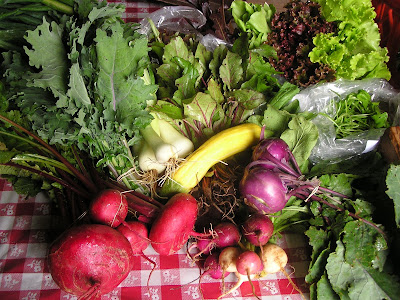
Welcome to Week Three of the CSA! This is an A week, which means groups Arugula (Wednesday) and Asparagus (Saturday) are picking up.
This week in your share you'll find:
Spring Onions
Easter Egg Radishes
Arugula
Lettuce Mix
Garlic Scapes
Your choice of Collards, Kale, or Swiss Chard
link to Worms Voice CSA newsletterNasturtiumsPronounced nuh-STER-shuhm, this delightful and completely edible flower can be found in abundance in our pick your own (PYO) this week! All parts of the nasturtium plant are edible, except for the roots, and the young leaves, stems and flowers have a peppery flavor. They are lovely tossed in salads and add a beautiful color to a flavored lemon butter. Consider adding easy to grow nasturtiums to your garden at home- edible landscaping!
We are including a few recipes for nasturtiums below, so take a handful home to play with this week.
Nasturtium-Lemon ButterThis butter has a light lemon flavor lightly accented with peppery nasturtiums. Try it with fish, chicken, broccoli, and asparagus. It is also excellent on white bread for just a hint of peppery citrus. Substitute another herb such as dill or cilantro for the nasturtiums for a different take on the butter.
• 1/2 cup unsalted butter at room temperature
• 2 teaspoons grated lemon peel
• 1 tablespoon lemon juice
• 3 tablespoons finely chopped nasturtium blossoms
Mix all of the ingredients well until smooth and well blended. Refrigerate or freeze until ready to serve. Makes 3/4 cup flavored butter.
Nasturtium and Strawberry SaladThis salad calls for nasturtium vinegar which has a lengthy production process. Use the vinegar to add flavor to lots of dishes and the effort will be worthwhile.
For the nasturtium vinegar:• 3 cups nasturtium flowers, (1 cup a week) washed and dried
• 2 cups white wine or Champagne vinegar
Lightly crush 1 cup of nasturtium blossoms with the back of a spoon and combine with the vinegar in a glass jar. Cover with a layer of plastic wrap and screw on a tight-fitting lid. Set aside in a moderately warm place (next to the stove, for example) for about three weeks, straining and replacing the flowers with a freshly crushed batch once a week. When the vinegar is ready, strain the flowers out and store the jar in a cool, dark place. Makes 2 cups.
Variation: Add a whole clove of garlic when you begin the steeping process.
For the Salad:
• ¼ c nasturtium vinegar
• 1 Tbsp balsamic vinegar
• 1 Tbsp honey
• 1 tsp Dijon mustard
• salt
• freshly ground black pepper
• ½ c extra virgin olive oil
• 1/3 c chopped fresh nasturtium blossoms
• 8 c mixed greens, washed, dried and torn into bite sized pieces
• 1 c small strawberries, quartered
• whole pansies, nasturtiums, chrysanthemum, or other edible blossoms for garnish
In a medium bowl, whisk together the vinegars, honey, mustard, and salt and pepper to taste. Slowly drizzle in the olive oil, whisking constantly, until the dressing has emulsified. In a large bowl, toss the dressing with the greens, strawberries and fresh flowers and serve immediately.
Butter Braised Radishes & GreensUnless you love fresh radishes sliced on all your salads, you may be wondering what to do with another bunch this week. We’d like to suggest resurrecting a recipe from last season and braising your radishes in a bit of butter. This method takes some of the bite out of the radishes and gives a nice, turnip-like texture. Experiment with the dish- adding thinly sliced garlic scapes infuses the dish with another dimension of flavor, and any chopped greens (collards, kale, braising mix, chard) aside from the radish greens, which are not particularly edible, can be added with the radishes for some color.
From the Washington Post
• 2 tablespoons unsalted butter
• 1 3- to 4-ounce spring onion, cut into 1/4-inch dice, tough dark-green top removed (may substitute sweet onion)
• 1 pound (two 1/2-pound bunches) radishes, cleaned, green tops removed, stem ends trimmed; small ones left whole, medium ones cut in half, large ones cut into quarters
• Salt
• Freshly ground black pepper
• Pinch sugar
• 1/2 cup water
In a pan large enough to hold the radishes without crowding, melt the butter over medium-high heat; allow it to begin to brown but not burn. Add the diced onion and reduce the heat to medium. Cook, stirring, for about 3 minutes, until the onion softens.
Add the radishes, salt and pepper to taste, the sugar and the water, stirring to combine. Increase the heat to high and bring just to a boil, then cover and reduce the heat to low. Cook for about 20 minutes, until tender.
Uncover, increase the heat to high and bring back to a boil; cook for about 4 minutes, until almost all the liquid has evaporated. Serve hot or warm.




















